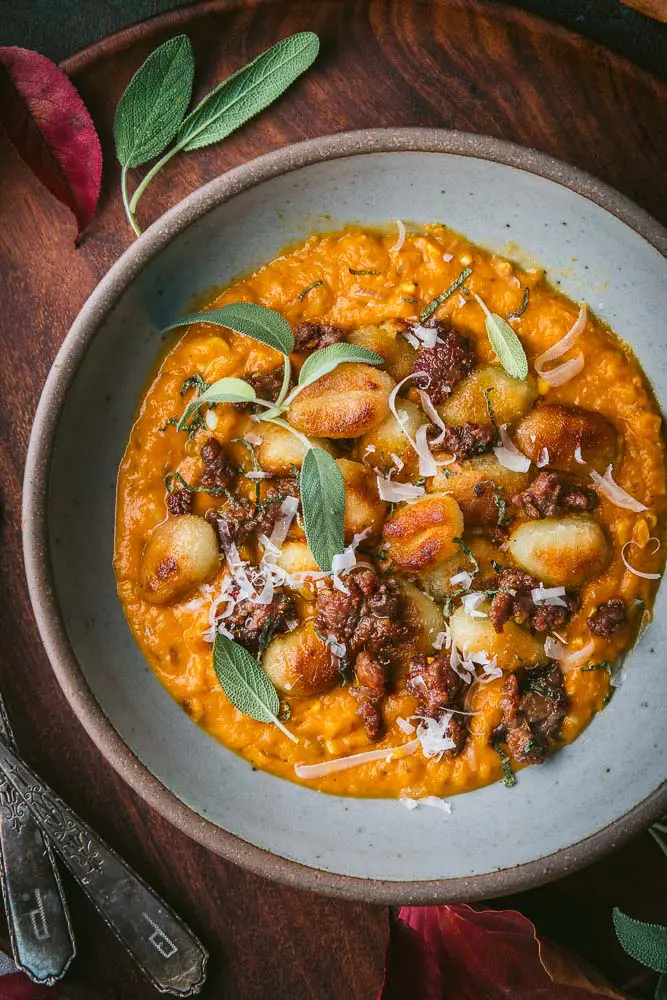
Crispy gnocchi with pumpkin sauce might be our new favorite fall weeknight dinner, and let us tell you why.
Whenever we make pasta, we cook extra so the next day we can heat it up in a skillet until it gets crispy on the bottom. This works with most types of pasta, but it’s especially good with short cut shapes which make good contact with the pan.
This concept works even better with (store-bought, shelf-stable) potato gnocchi because you don’t even need to boil them first. Packaged gnocchi are sturdier than the home-made kind. They crisp up easily and can be tossed around with a spatula without needing a careful touch. We like using a skillet because it’s easier to get the gnocchi super golden brown and extra crispy. You could also toss them with a little oil and bake them on a sheet tray, if you’d rather.
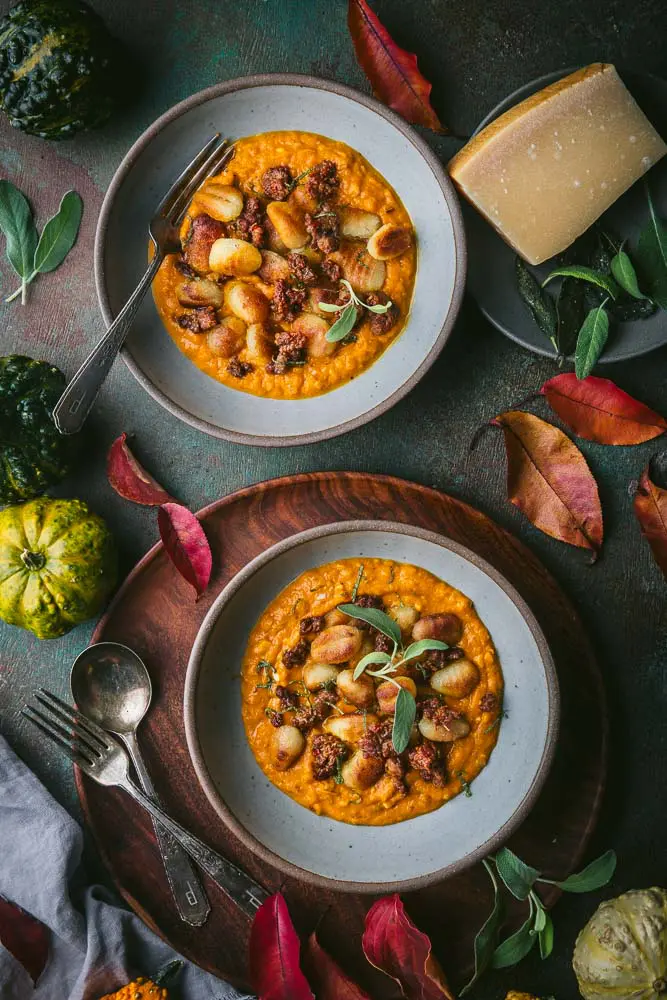
GNOCCHI WITH pumpkin sauce, not pumpkin spice
Unless you’ve been living under a rock, you’re aware that “pumpkin spice” is basically a national phenomenon. A quick Google search turned up pumpkin spice cat litter, air freshener, deodorant and even toilet paper (!). I really try not to yuck people’s yum but … yuck. Just who is yumming on this? Who?
Another downside of this autumnal obsession is that when people hear “pumpkin”, they think of cinnamon, ginger, nutmeg, allspice, and cloves. That same combination could just as easily have been called “apple pie spice”, since it uses the same flavor mix.
So let’s liberate the pumpkin and strip it of its cinnamon-scented shackles. (Were we songwriters, we would now insert an inspiring Hamilton-esque action ballad. We might call it Gourd Only Knows.) Canned pumpkin has a mild vegetal sweetness, and is the perfect texture for a silky sauce. When combined with the softened shallots, garlic, chili flakes and sage we’re using in this recipe, pumpkin is distinctly un-dessert-like.
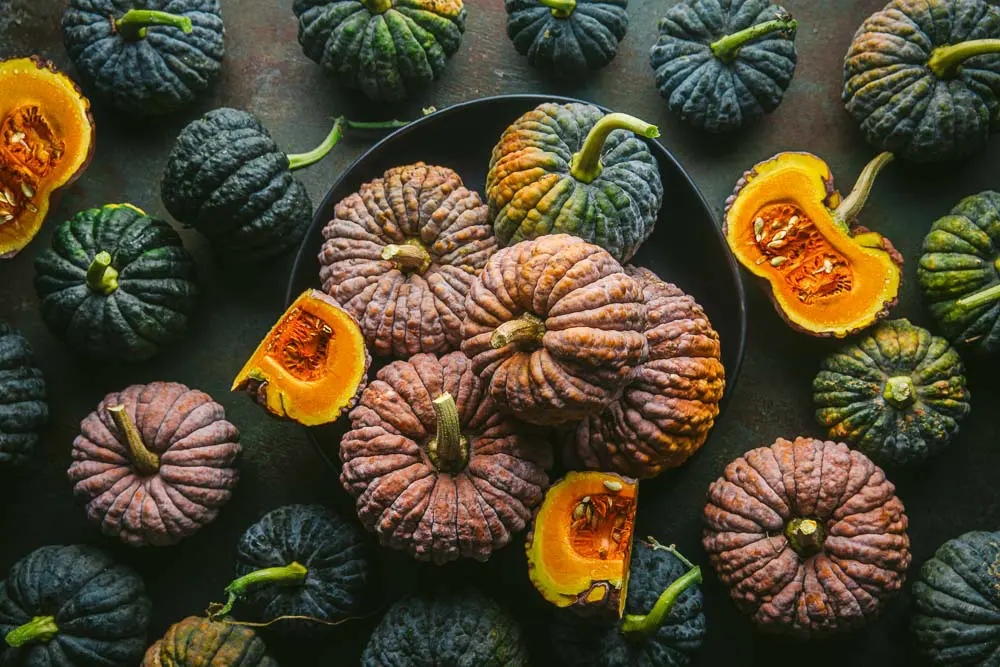
what even is canned pumpkin?
You may have heard people say “canned pumpkin is actually squash” and that’s both true and false. The fact is that any hard-skinned squash (sometimes called “winter squash” or “storage squash”) is in the gourd family. You could call the fruit of any such cultivar a “pumpkin” without offending an agronomist, but we tend to reserve the moniker for squash that are particularly round and orange.
The most common brand of canned pumpkin in the U.S. is Libby. They use a proprietary strain of pumpkin called the Dickinson (which is sometimes referred to as Dickinson squash). It’s most closely related to butternut squash, which has sweet, delicate flesh and happens to be one of our favorite squashes for roasting, mashing or making into soups.
This is not a sponsored post but in our testing, Libby had the best flavor, color and texture, so we recommend it.
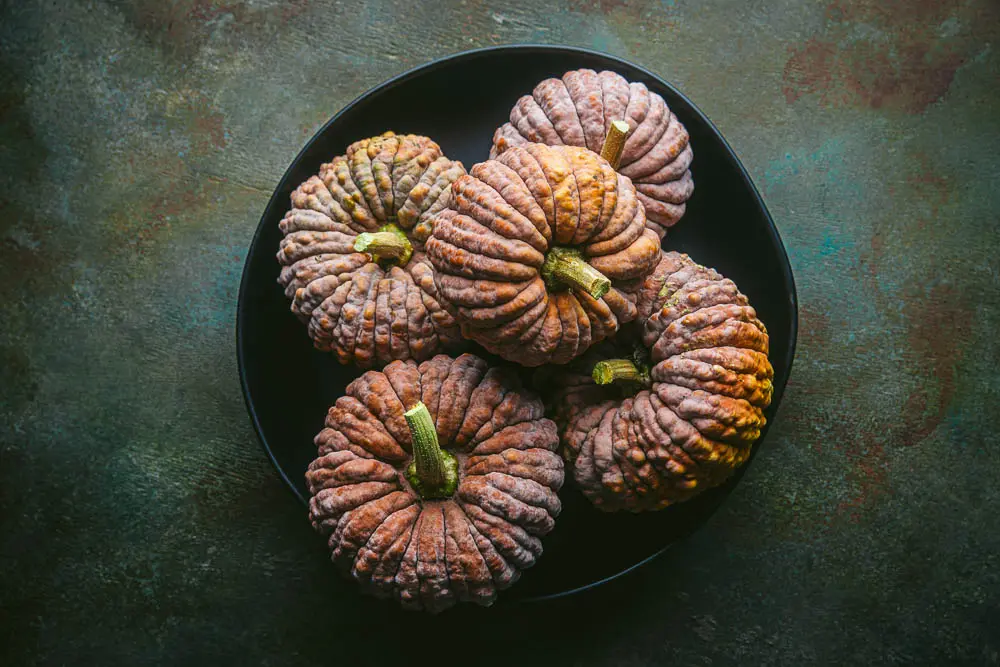
why is canned pumpkin better than fresh?
“Better” is always a relative term. We recommend using canned pumpkin for our gnocchi-and-pumpkin recipe because homemade purees can be watery. Canned pumpkin is not only more consistent, it also tends to have a smoother, silkier texture.
It just so happens that canned pumpkin is actually more nutrient dense that raw pumpkin, because the cooking and canning process concentrates the pulp. That means there will be more more protein and fiber in canned compared to homemade.
So save your pumpkins, gourds and squashes for roasting and reach for the canned variety for sauces and pies.
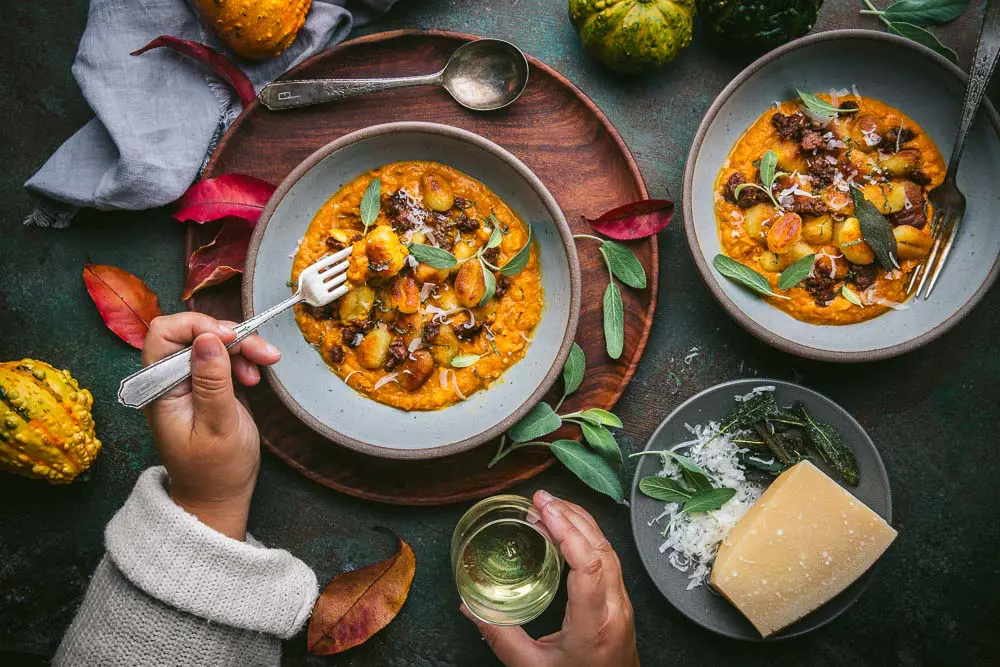
no need to pre-boil the gnocchi
One of the things that makes gnocchi with pumpkin sauce such a great weeknight meal is that everything cooks not just quickly, but in one skillet. (We keep both gnocchi and sausage warm in the oven, but you could just as easily tent it on a plate with foil to keep it warm).
If you’re making the crispy fried sage, heat up a little olive oil in a skillet and when the oil is shimmering, add the sage leaves. They’ll sputter and sizzle as the moisture evaporates, and they’ll turn crisp and mellow in about 20 to 30 seconds. Remove them with a slotted spoon, leaving the oil in the skillet, and immediately give them a little sprinkle of salt. Note that if the two tablespoons of oil specified in the recipe isn’t enough to crisp the sage, either add a little more or tilt the pan slightly, allowing the oil to pool on one side. Move the sage to that little pool and let them sizzle away until crisp.
Now it’s time to cook the gnocchi. If you didn’t make the crispy sage, heat the skillet and add the oil. Otherwise, keep the skillet on medium-high and use the sage-infused oil.
If the gnocchi is a little stuck together, separate them and add the gnocchi to the skillet in an even layer. Cover the pan, which allows them to steam and become tender as the bottom crisps. Let them cook, trying not to move them around, until the gnocchi turn golden brown on the bottom. Flip and cook them until crisp on the other side, no need to cover this time. If the gnocchi are getting too dark, lower the heat a bit, or if the skillet looks dry, add more oil as needed. Transfer the gnocchi to a sheet tray and spread them into a single layer to keep them from steaming. Either place them in a 250ºF oven to keep warm, or loosely cover the tray with foil.
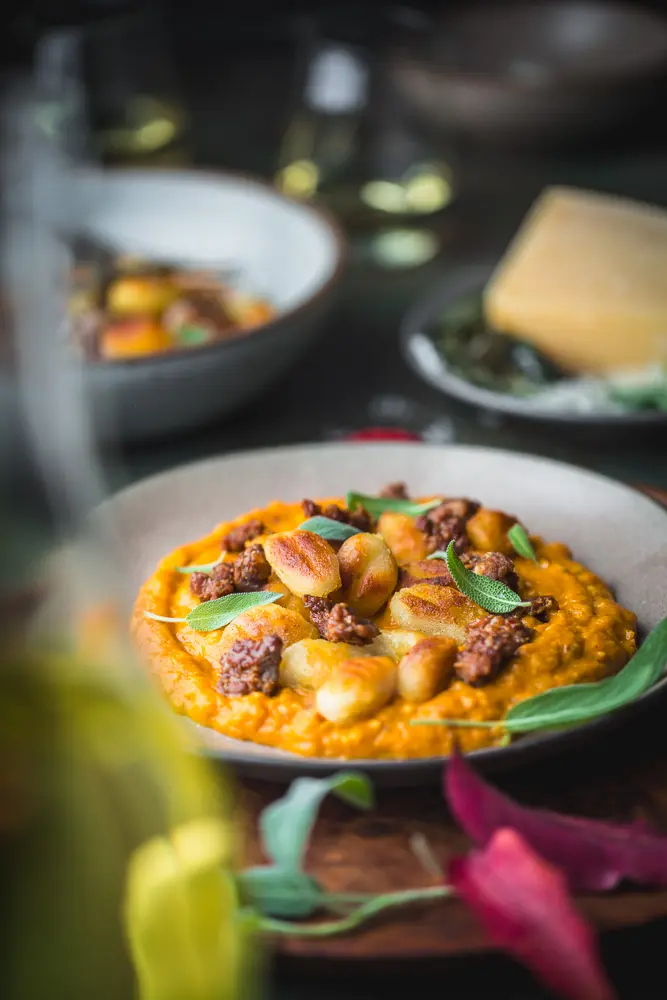
Add A little sausage
Keep the skillet on medium-high heat and add another tablespoon of oil. Add the sausage and use a wooden spoon or, even better, a potato masher to break it into small pieces and press flat to get as much contact with the pan as possible. Cook the sausage, undisturbed, until the sausage is brown on the bottom. Then stir, continuing to break up any larger pieces, and cook the sausage through. Transfer the sausage to the tray with the gnocchi and keep it warm in the oven (or under the tented foil) while you make the sauce.
Making the Pumpkin Sauce
The fat content in sausages can vary so if there’s a lot of fat in the skillet, remove some, leaving about 1 tablespoon or so. If the pan is dry, add a little more oil. Reduce the heat to medium and add the shallots and sauté for a few minutes until they turn translucent, then add garlic and sauté for about 30 seconds longer, until it smells fragrant.
If you’re using chopped or dried sage in the sauce (along with or instead of crisped on top), add it with the garlic.
Add the wine and scrape up any brown bits stuck to the bottom of pan and allow the wine to reduce by about half which should take another couple of minutes. Add the pumpkin puree and the broth and stir to combine. Reduce the heat and let it simmer for 5 minutes, then stir in mascarpone until it melts and simmer until the sauce is nice and thick. Season the sauce to taste with salt and pepper.
If you want, you can stir the gnocchi and sausage into the sauce directly. Since we like to keep the gnocchi crisp, we add a layer of sauce to the bowls and top it with the warm gnocchi and sausage. Garnish the sausage, gnocchi and pumpkin with the crispy sage (if you made it), and shave on some fresh parmesan.
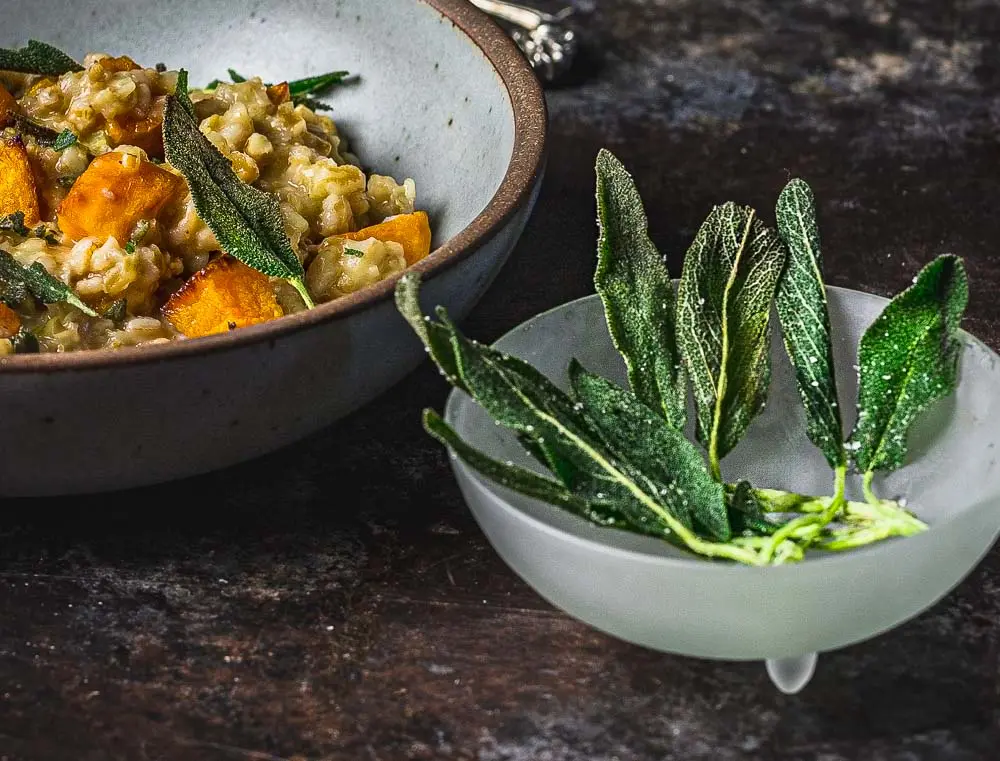
crispy fried sage is optionAL (but you should do it)
Even if sage is not your favorite herb, once it’s fried to a crisp and lightly salted, you might just be a convert. It’s like fragrant, herby potato chips. The flavor is a lot milder and nuttier than fresh (or freshly chopped) sage. It only takes a minute or so to make and it’s so delicious. We love to use it on top of risotto, with cheese or on charcuterie boards, really on anything that would benefit from a crispy, herbal topping.
So there you have it. Crispy gnocchi with pumpkin sauce, sausage and sage. If the recipe doesn’t quite exorcise the demon of pumpkin spice, we hope we have at least sprinkled a little holy water in its face. Happy autumn!
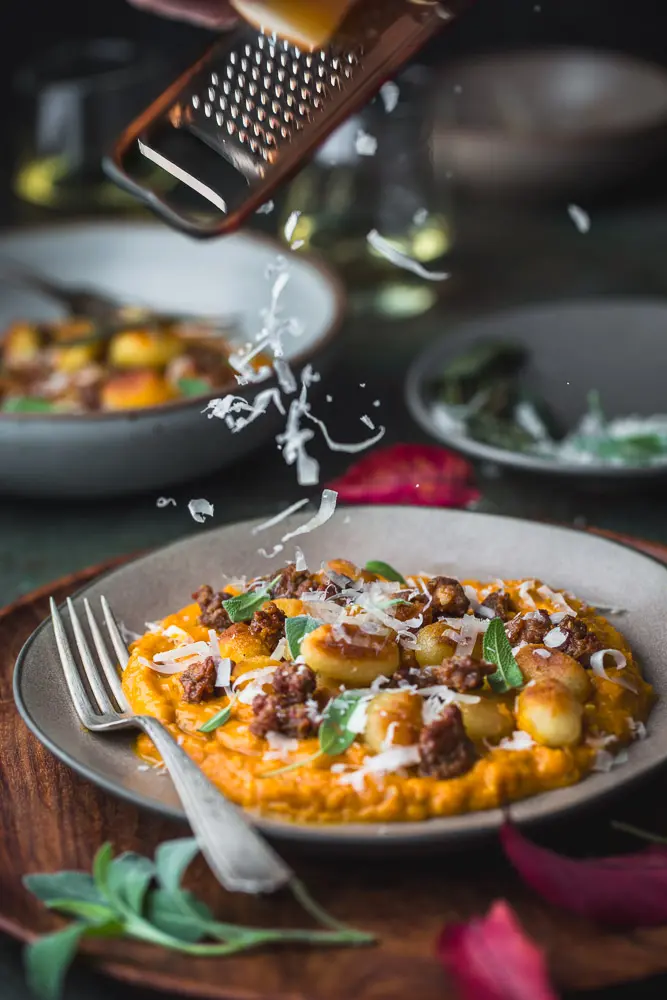
Crispy Gnocchi and Sausage with Creamy Pumpkin Sauce
Ingredients
- 3 tablespoons extra-virgin olive oil divided, plus more as needed
- 8 – 10 fresh sage leaves + 1 tablespoon chopped sage*
- 1 12 to 18 ounce package shelf-stable potato gnocchi
- 1 pound hot or sweet Italian sausage casings removed if links
- 3 large shallots or 1 onion, finely chopped (about 1 cup)
- Kosher salt and freshly ground black pepper to taste
- 5 garlic cloves minced (about 1 1/2 tablespoons)
- 1 teaspoon crushed red pepper flakes
- 3/4 cup dry white wine
- 2 cups (15oz can) canned pumpkin (unsweetened)
- 1 1/2 cups chicken or vegetable stock
- 1/2 cup mascarpone cheese or cream cheese or heavy cream
- 1/2 cup grated Parmesan or Pecorino Romano cheese for serving
Instructions
- Heat oven to 275ºF and set a rack in the middle. Pull apart any stuck-together gnocchi.
Make the crispy sage (optional)
- In a large (10 or 12-inch )seasoned cast iron or nonstick skillet, heat 2 tablespoons oil over medium-high. When oil is shimmering, add sage leaves in a single layer. You can tilt the pan to pool the oil and move the sage into that area, if there’s not enough oil to make the sage leaves sizzle. Let them cook until crisp, about 30 seconds. Remove them with a slotted spoon to a plate lined with paper towels. If desired, sprinkle lightly with salt, to taste. Set aside. Use the sage-flavored oil to cook the gnocchi.
Make the Gnocchi
- If you didn’t crisp the sage, add the oil to the skillet on medium-high and heat until shimmering. Add gnocchi to the skillet in an even layer. Cover and cook, undisturbed, until the gnocchi are golden brown on the bottom, 2 to 4 minutes. Flip and cook, turning as needed, until crisp all over, about 4 to 5 minutes. If the gnocchi are getting too dark, lower the heat a bit, or if the skillet looks dry, add more oil as needed. Transfer to a sheet tray and spread into a single layer to keep from steaming. Place in oven keep warm.
- Add another tablespoon oil to the skillet, still over medium-high. Add the sausage and use a wooden spoon to break into small pieces and press flat. Cook, undisturbed, until sausage is browned, 2 to 4 minutes. Stir and cook until the sausage is cooked through, another 2 to 4 minutes. Transfer to the tray with the gnocchi and keep warm in the oven while you make the sauce.
- If there’s more than 1 tablespoon of fat in the skillet, remove some. Turn the heat down to medium and add a little more oil if pan is dry. Add shallots, season with salt and pepper, and sauté until translucent, 2 to 3 minutes. Add garlic, pepper flakes and chopped sage and sauté until fragrant, about 30 seconds.
- Add wine and scrape up any brown bits stuck to the bottom of pan. Allow wine to reduce by half, about 2 minutes. Add pumpkin and broth and stir to combine. Reduce heat and simmer for 5 minutes. Stir in mascarpone (or cream) until melted and sauce is nice and thick. Season to taste with salt and pepper.
- To serve, add a layer of sauce to a bowl and top with 1/4 of the warm gnocchi and sausage. Repeat with the rest of the gnocchi, sausage and sauce. Garnish with crispy sage (if using), and sprinkled parmesan and serve immediately.
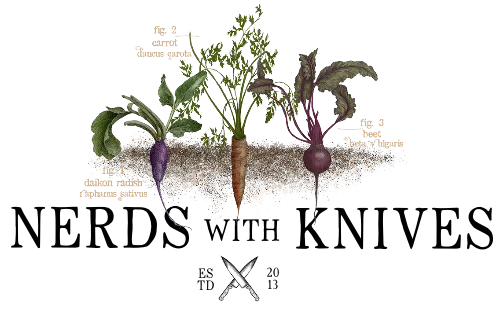

Wow. The pumpkin with the gnocchi and sausage combines for a very savory dish. I didn’t add the parmesan (I didn’t think it needed it) but the crispy sage was a fine topping. I will be making this again.
You mention crushed red pepper in the ingredients list but not in the re ipe directions. Is it just added to the sauce?
Hi Amy, thanks for catching that! I’ve fixed the recipe. The chili flakes should be added along with the garlic but really you could add them at any point.
Cheers,
Emily
I left out the red pepper, too spicy for me. Used half and half with a pat of butter instead of cream.
We love the texture of the gnocchi in this dish! I am finding we have a lot of extra sauce, so I will probably make more gnocchi to go with the leftovers… Any other ideas?
Glad you liked it! You could stir it into risotto or smear it on some good toasted bread and top it with a little cheese (then broil for a pumpkin cheese toastie!)